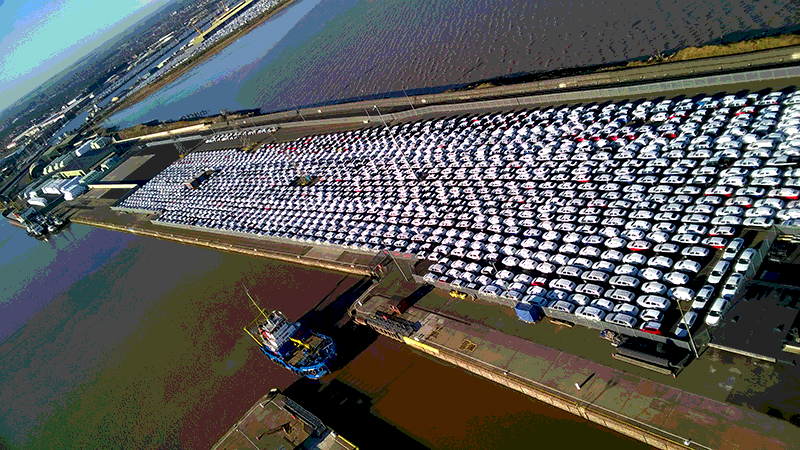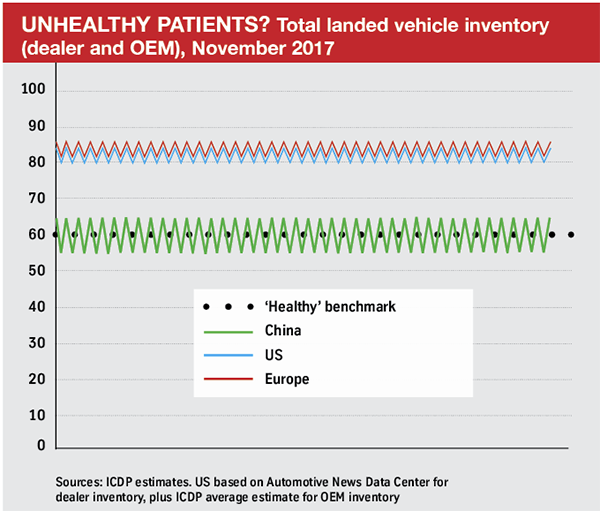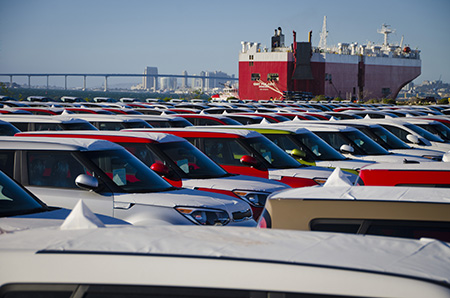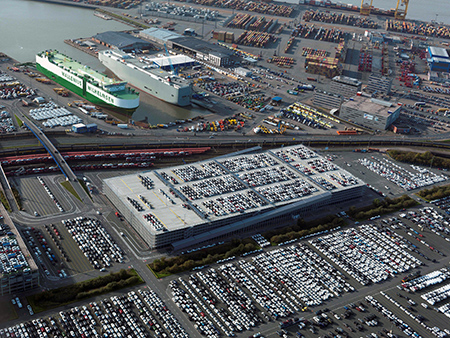 In any retail business, inventory management is a delicate balancing act. Hold too little and frustrated customers will be forced to shop elsewhere; but piling stock on your shelves puts a strain on working capital and if what you bought isn’t what customers want, you have little choice but to sell it off at discounted prices.
In any retail business, inventory management is a delicate balancing act. Hold too little and frustrated customers will be forced to shop elsewhere; but piling stock on your shelves puts a strain on working capital and if what you bought isn’t what customers want, you have little choice but to sell it off at discounted prices.
In the car business, those challenges are amplified by multiple factors. The products are high in value, bulky and expensive to store or move around. And complex product portfolios with multiple options make it especially difficult to match supply with real customer demand.
A decade ago, the automotive industry had a tough lesson in the risks of supply-demand mismatch. The global financial crisis in 2008 triggered a double-digit percentage drop in sales in many major markets. By the time vehicle manufacturers responded to the change, ports and distribution parks were overflowing with unsold vehicles and logistics personnel were scrambling to find places to keep their excess inventory. It took years of government stimulus programmes, widespread restructuring and the bankruptcy of several major players before normality returned.
That bruising experience forced carmakers to rethink their strategies. They trimmed excess capacity from their production and distribution networks, increased their focus on the management of working capital and strove to make production more agile and responsive.
After a few good sales years, has the industry forgotten those lessons? Ben Waller is associate director of ICDP, a UK-based consultancy specialising in automotive distribution. “There used to be a rule of thumb, globally, that finished vehicle inventories in the market were equivalent to 60 days of sales,” he says. “In the US, that’s been the case for a very long time, but recently there have been signs that inventory in China is starting to creep up after being relatively controlled there for a long time.”
In Europe, the shift is even more pronounced. “Europe has always been slightly different, because production flexibility allowed manufacturers to sell more from their pipeline. That helped inventories drop considerably from the mid-1990s to the early 2000s. Then they started to creep up before the financial crisis. Since then, there was a period where carmakers were more disciplined, but it is clear that discipline has slipped, partially due to increased volatility of demand within markets and product mix.”
 In November 2017, ICDP’s data suggests that inventories of landed stock for volume brands in Europe stood at over 80 days, up from 55 days in the early 2000s. In the US, the latest data from Automotive News puts dealer inventories at 71 days (down from 76 days earlier in the year), although ICDP estimates that OEMs typically hold another 10 days of inventory. The picture in China is more volatile, but dealerships' inventory has varied between 35 and 48 days recently, with the overall landed pipeline around 60 days.
In November 2017, ICDP’s data suggests that inventories of landed stock for volume brands in Europe stood at over 80 days, up from 55 days in the early 2000s. In the US, the latest data from Automotive News puts dealer inventories at 71 days (down from 76 days earlier in the year), although ICDP estimates that OEMs typically hold another 10 days of inventory. The picture in China is more volatile, but dealerships' inventory has varied between 35 and 48 days recently, with the overall landed pipeline around 60 days.
Some fluctuation in inventory levels is an inevitable part of local market dynamics. In the UK, inventories tend to rise in advance of the twice-yearly sales peaks associated with registration plate changes. In China, meanwhile, carmakers gear up over the summer for the traditional November-January sales peak, which was expected to be especially steep in 2017-2018 as customers rushed to beat planned tax increases.
In other cases, carmakers just get their forecasts wrong. During 2017 in the UK, for example, many manufacturers were caught out when, after an extended period of strong growth, customers were far less enthusiastic than expected during the September sales peak. The sale of very low-mileage, pre-registered vehicles, once a peculiarity of a few markets, is now becoming more common across Europe and elsewhere, Waller notes.
The brakes don’t workEven if they can read the signs, says Alan Braithwaite, senior advisor to LCP Consulting and visiting professor at Cranfield University School of Management, carmakers may not be able to flex their production fast enough to stop inventories rising in a downturn.
“Car companies set their run rates based on their expected market forecast and they put in place probably three to four months of the supply chain behind that, together with shift commitments to their staff and all the rest of it,” he says.
If the usual measures used to stimulate demand don’t work and dealers aren’t moving their stock quickly enough, he adds, “the whole process just backs up through the supply chain. In the short term it’s finished vehicle inventories that take the pressure.”
Even as they move from one planning period to the next, manufacturers may have only limited opportunity to adjust production, says Braithwaite. “In essence, it’s all about car plant shifts. If you start off running five shifts with a bit of overtime, the easiest thing you can do is get rid of the overtime. After that, you have to look at taking out a shift, or going to a three-day week until the excess inventory works its way through the system,” he states.
Carrying out such changes is difficult, however, since any adjustment in production rates has to feed back into the supply of thousands of components from hundreds of upstream suppliers. “When you look at the complexity involved and the agreements that are in place, you realise that a vehicle supply chain is a pretty big and difficult thing to turn around quickly,” says Braithwaite.
Braithwaite suggests that there may also be cultural factors at play. Many manufacturers have enjoyed a prolonged period of strong demand and rising sales. “It’s my experience that corporate memories tend to be rather short,” he says.
 "When you look at the complexity involved and the agreements that are in place, you realise that a vehicle supply chain is a pretty big and difficult thing to turn around quickly." - Alan Braithwaite, LCP Consulting
"When you look at the complexity involved and the agreements that are in place, you realise that a vehicle supply chain is a pretty big and difficult thing to turn around quickly." - Alan Braithwaite, LCP Consulting
A buoyant market can catch manufacturers out as much as a declining one. Tom Swennes is vice-president of strategic planning and administration at ICL Systems, a US-based provider of logistics management systems and solutions for finished vehicle networks. In the first half of 2017, he notes, there was a pronounced acceleration in the ongoing shift in customer preference from smaller sedans to larger trucks and SUVs. “The manufacturers knew the change was happening, but I think some of them were caught out by the speed and size of the shift,” he says. That change meant that, while supply was tight in some categories, there were plenty of unsold smaller cars swelling inventories across North America.
Even if supply and demand are broadly in balance, operational challenges can create local inventory peaks. Swennes says the US saw several such situations in 2017, including transport disruption in the south-east caused by two major hurricanes this past autumn, and disruption in the rail network.
These factors, together with more “everyday” issues like new model launches and quality holds, combined to push inventories up sharply. Swennes estimates they were 15-20% higher than their typical pre-summer peak in 2017. By the end of the year, however, the spike had passed, with inventories much closer to normal levels.
Operational issues can challenge carmakers everywhere. Rob Garratt is an executive partner at IBM and works closely with leading carmakers. “The more advanced cars become, the more technical complexity going into them and the more options you have available, the greater the risk of mismatch between what the customer has selected and what can be built; or that the selected options are not common, parts are missing and near-complete vehicles have to be taken off the line while parts availability is resolved,” he says. As a result, he suggests, “there are rising numbers of finished or nearly finished vehicles sitting around causing strain on the system.”
[mpu_ad]Other, more subtle influences are also at work, says ICDP’s Waller. “The long period of exceptionally low interest rates has made overstocking more affordable,” he notes. There has also been a change in the way the costs and risks associated with inventory are distributed among supply chain participants. “After the financial crisis, manufacturers took a long, hard look at their financial exposure. The upside of that was a desire to ensure that inventories represented a more acceptable level of risk for themselves and for their dealers,” he says. “The downside was a greater focus on getting those inventories off the manufacturers’ balance sheets sooner to minimise their exposure. Some of that has involved expecting the dealers to take a greater share of the inventory risk, which is clearly problematic as far as the dealers are concerned.”
This shift in the ownership of inventory can have distorting effects on carmaker incentives, too. If a manufacturer can book the revenue for a vehicle before it reaches the end customer by selling to its dealer network, there is less reason to make quick changes to production plans, says Waller. That’s especially true where manufacturers expect their dealerships to commit to orders or meet specific stock and wholesale targets.
Feeling the strainRegardless of the underlying reasons for the change, rising inventory levels are putting increased strain on infrastructure. That’s being felt across the value chain, from dealerships back through distribution facilities to ports.
In North America, ICL’s Tom Swennes notes that the availability of transport assets, like trucks and rail wagons, has been under pressure for some time, following several years of strong market growth. That makes local peaks in demand harder to manage, with imbalances in one area exacerbating problems elsewhere. “We definitely saw quite a bit of that this year,” he says.
Discomfort has arrived quickly in Europe, says ICDP’s Waller, because the industry did a good a job stripping away excess capacity during the downturn. “After the financial crisis, big chunks of capacity disappeared. And one of the most significant areas of reduction was compounds and ports.”
While redundant shipping assets can be mothballed or re-allocated, giving up physical storage space tends be a more permanent change. “Once the land is gone, it can be quite hard to find a new place for the storage of vehicles,” says Waller. And even if suitable space is available, landlords need the confidence that long-term demand will be sufficient to justify development.
There is evidence that a number of supply chain participants are confident enough to make those kinds of longer-term capacity investments. The port of San Diego in California has carved out an important niche in the import of vehicles to the US. From 30,000 vehicles annually in the mid 1990s, the port now handles more than 400,000 units every year. Today, 117 acres (47 hectares) of the terminal are dedicated to vehicle handling storage, along with another 40-50 acres of off-site space.
According to the port’s maritime director, Joel Valenzuela, while the continued growth of its automotive volumes is good news, the speed with which inventory moves through its facilities can create challenges. “Ideally, we’d like to see a dwell time of around seven days for vehicles, but right now we are on 14 or 15 days,” he says.

The underlying reasons for that increased dwell time aren’t simple, says Greg Borossay, principal of maritime business development at the port, but a mismatch between supply and demand is certainly an important factor. “It does seem that some of the manufacturers have a little more sensitivity in terms of tying their manufacturing back to their sales and responding more quickly, whereas others do not,” he says.
The port is undertaking a number of projects to increase its capacity in the face of the rising pressure on its facilities. “We are redeveloping an old tank farm within the facility so it can be reused for storage and we are doing some internal road closures so that the operating areas are more contiguous and efficient,” says Valenzuela. An impact study is also underway for a rail improvement project that would allow the port to double the number of unit trains leaving the facility.
San Diego is also doing what it can to shape demand, for example increasing the prices it charges for vehicles that sit in its property for extended periods. Such strategies can only achieve so much, however, if there is nowhere else for the inventory to go.
In the UK, Clive Thomas is head of commercial and property for the port of Southampton, part of Associated British Ports group (ABP). He is also head of automotive business for the group, which handles around 1.8m vehicles a year across several ports and compounds.
Over the past five years, says Thomas, ABP has invested in a pipeline of site acquisitions around Southampton and the Humber to support continued growth in its automotive business, including 150 acres added recently for vehicles. Land in the Southampton area is at a premium, driving the development of multi-storey structures for vehicle operations.
“In the past two months [October and November], we’ve opened a new export facility in our eastern docks in Southampton with 3,400 export spaces, and at the same time we are working on a 4,400 space import deck in the western docks,” he notes. “That’s around £25m ($33.4m) of investment in new capacity and we anticipate building two further multi-storey structures over the next two to three years.”
ABP is also exploring ways to streamline the flow of vehicles through its UK facilities. “We are working with various parties, looking at things like automated inspection facilities to provide greater visibility on the condition of vehicles as they move through the port,” says Thomas, adding that the company is also considering how technology will shape the port over the next 25 years, including autonomous and semi-autonomous vehicles.
 "After the financial crisis, big chunks of capacity disappeared. And one of the most significant areas of reduction was compounds and ports. Once the land is gone, it can be quite hard to find a new place for the storage of vehicles." - Ben Waller, ICDP
"After the financial crisis, big chunks of capacity disappeared. And one of the most significant areas of reduction was compounds and ports. Once the land is gone, it can be quite hard to find a new place for the storage of vehicles." - Ben Waller, ICDP
There is the potential to make more efficient use of available infrastructure. At ICDP, Ben Waller says this is an area with significant potential in many markets. “We have long argued that greater centralisation of inventory has significant benefits for carmakers, dealers and customers,” he says. “By keeping manufacturer- and dealer-owned inventories in a common location, you reduce transportation costs, improve the liquidity of inventory and improve the probability that the customer will be able to access the vehicle they want.”
That model is already common in some markets, like the UK, where carmakers including Ford have operated such a system. Ford holds centrally stored stock for British dealers at the port of Flushing in the Netherlands (and has recently adopted a similar model for other markets in Europe). However, it has been relatively slow to catch on elsewhere, says Waller.
Digital insightsAt IBM, Rob Garratt notes that manufacturers may be able to find technical solutions to many of the issues that currently drive excess inventory. More sophisticated vehicle configuration systems will reduce the chance that customers order vehicle specifications that can’t be delivered, for example. And the transition to multi-model production lines will make it easier to ensure the model mix coming out of the factories is right for the market. “Many carmakers still run a single production line for each model, but it is clear that a lot of them are heading in the direction of ultimate flexibility, where you can send any vehicle down any line,” says Garratt.
Then there’s forecasting. The industry could still become better at ensuring that the cars it puts into a market are the right ones for that market. “A lot of dealers will argue that an ageing stock problem begins the moment the vehicle is ordered,” says Waller. “It happens because you put the wrong vehicle with the wrong specification in the wrong place.”
 Some executives think digital technology could improve supply chain communication and help to reduce inventories
Some executives think digital technology could improve supply chain communication and help to reduce inventoriesFor manufacturers, says Waller, excess stock carries hidden penalties that go beyond the direct cost of financing, storing and handling the vehicle. “Handling ageing stock requires a lot of admin time, and then there is hidden discounting that arises when you offer the customer an alternative to the car they originally asked for. And while the customer might feel they are getting a good deal, the inability to give the customer their first choice of vehicle can damage a brand over time.”
IBM’s Rob Garratt suggests that, while digital technologies cannot completely solve the demand-planning problem, there are new approaches that can inform and improve forecasting activities as part of a more sophisticated sales order and planning function. “For example, you now have the ability to use social media to understand what people are thinking about the cars they want to buy,” he says.
Other emerging technologies promise to streamline communication across the supply chain. Blockchain technology, which underpins crypto-currencies like bitcoin, could provide a secure mechanism for sharing forecast data, he notes.
Digital technologies offer a range of new approaches to help car companies understand and forecast customer demand, and supply chain participants optimise their assets. But old-fashioned human communication still has a critical role to play, says ICL’s Tom Swennes. “The key for any of this stuff is communication and transparency with your supply chain partners.”
[related_topics align="right" border="yes"]Inventory spikes and operational challenges are inevitable, he says, but can be mitigated by contingency plans developed with vendors. ABP’s Clive Thomas echoes that view: “For us, it’s a lot of dialogue with the shipping lines to make sure that we can plan the arrivals efficiently. We have 1,200 ships from 11 lines a year coming here with automotive trade. It takes a lot of planning to get that part of it correct. We need to make sure that we’re sharing as much information as openly as we can with the shipping lines and with our compound partners.”
Looking beyond your own supply chains matters too, concludes Swennes: “Systems like ours are designed to help car companies achieve complete visibility of their own networks, but what you don’t see is what your competitors are doing. We are operating in a shared asset environment, so interacting on an industry level is very important.”



































